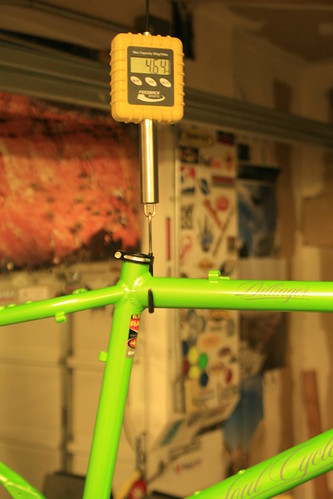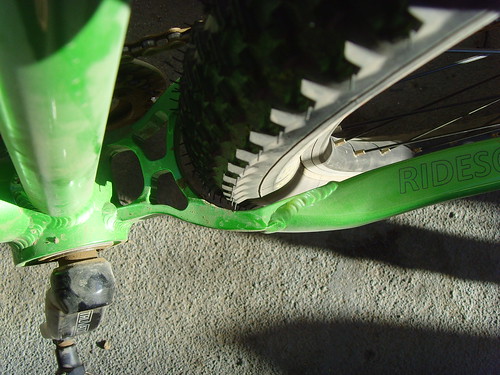Review: Soul Cycles Dillinger
Over the past few months we’ve been lucky enough to test the Soul Cycles Dillinger 29er hardtail. The Dillinger has been a fun ride and served as our test bed for the Powercordz cables, Geax Saguaro and Serfas Tegu reviews.

Beautiful construction abounds on the Soul Cycles Dillinger
Not only is the Dillinger gorgeous in bright lime green, the construction impresses too. The Dillinger is a lightweight, versatile EBB (eccentric bottom bracket) frame. It ships with a derailleur hanger and singlespeed dropout, is disk and V-brake compatible and Soul Cycles even sells a rigid fork! We ran the Dillinger as a singlespeed 29er with disk brakes and a 100mm RockShox Reba. You can read more about the build here.
At first I was nervous about the Dillinger’s set screw eccentric bottom bracket and aluminum hardtail construction. My EBB fears were dispelled as it was easy to adjust, stayed tight and never produced a creaking noise. Very good job Soul Cycles! As far as the aluminum hardtail, I’ve given up on 26″ wheels. I’d switched to 26″ steel hardtails and have been loving it ever since. They damp out that high frequency buzz that sends your hands and nether regions into a land of numbness. Amazingly the Soul Cycles Dillinger does this as well. I know a lot of the credit goes to the larger 29″ tires, but it is quite obvious some thought and engineering into the seat and chain stays on the Dillinger.

When they say Easton Ultralite Tubing, they mean it! (Weight w/ EBB and seat post clamp, 16″ frame size)
Overall the Dillinger has been a very fun ride, it is uber-light and plush for a hardtail. Yet it remains efficient under power. Compared to my Redline Monocog (26″ steel singlespeed), the Dillinger climbed with more authority thanks to the 29″ tires better contact patch and smoother rolling nature. On descents, the Dillinger mobbed over the terrain and showed me why everyone is now racing 29″ wheels in the SS categories.
My dislikes (compared to my Monocog) include the slower steering (though it offered more stability) and the higher up in the air sensation. The Dillinger has a nice low BB height however and this sensation was purely mental and can be adjusted to. The slower steering is a common trait among 29ers. I do not want you to have the impression that the steering is slow, it is just not as fast as on my 26″ race bike.

Chainstay yoke around a 2.2 Geax Saguaro tire.
A small concern I have is tight mud-clearance at the chainstay yoke, though this is not an issue in SoCal! The last nit pick I have is the cable stop location resulted in me catching my baggy shorts on occasion, but is definitely not a deal breaker.

The Moe at work
Bottomline: The Dillinger is a fantastic buy as is. When you factor in the reasonable prices and quality construction, it becomes clear that the Dillinger is head and shoulders above most of the 29er field. In fact Moe is thinking about forking out the cash to keep this bike in his personal fleet!
Great review and good looking bike, though I’m not sure I’m sold on the EBB–I’ve got sliders on my On One. Like you, the clearance looks a tad too tight for the rear tire and being in Utah, we get our share of mud from time to time.
Thanks for the review!